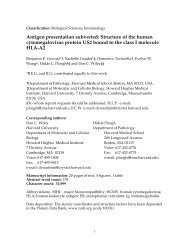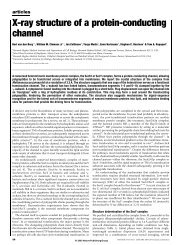Structure of the dengue virus envelope protein after membrane fusion
Structure of the dengue virus envelope protein after membrane fusion
Structure of the dengue virus envelope protein after membrane fusion
Create successful ePaper yourself
Turn your PDF publications into a flip-book with our unique Google optimized e-Paper software.
articles<br />
anchor’ formed by Trp 101 and Phe 108. The bowl is lined by <strong>the</strong><br />
hydrophobic side chains <strong>of</strong> Leu 107 and Phe 108, so that it cannot<br />
accommodate lipid headgroups. We expect that fatty-acid chains<br />
from <strong>the</strong> inner leaflet <strong>of</strong> <strong>the</strong> <strong>membrane</strong> may extend across to contact<br />
<strong>the</strong> base <strong>of</strong> <strong>the</strong> <strong>fusion</strong>-loop bowl, or that fatty-acid chains from <strong>the</strong><br />
outer leaflet may bend over to fill it. In ei<strong>the</strong>r case, insertion will<br />
produce a distortion in <strong>the</strong> bilayer, which could be important for <strong>the</strong><br />
<strong>fusion</strong> process (see below).<br />
A post<strong>fusion</strong> conformation<br />
The folding back <strong>of</strong> domain III and <strong>the</strong> rearrangement <strong>of</strong> b-strands<br />
at <strong>the</strong> trimer interface projects <strong>the</strong> C terminus <strong>of</strong> sE towards <strong>the</strong><br />
<strong>fusion</strong> loop, and positions it at <strong>the</strong> entrance <strong>of</strong> a channel, which<br />
extends towards <strong>the</strong> <strong>fusion</strong> loops along <strong>the</strong> intersubunit contact<br />
between domains II (Fig. 4a, b). The 53-residue ‘stem’ connecting<br />
<strong>the</strong> end <strong>of</strong> <strong>the</strong> sE fragment with <strong>the</strong> viral trans<strong>membrane</strong> anchor<br />
could easily span <strong>the</strong> length <strong>of</strong> this channel, even if <strong>the</strong> stem were<br />
entirely a-helical. By binding in <strong>the</strong> channel, <strong>the</strong> stem would<br />
contribute additional trimer contacts with domain II <strong>of</strong> ano<strong>the</strong>r<br />
subunit (Fig. 4b). The stem does indeed promote trimer assembly<br />
even in <strong>the</strong> absence <strong>of</strong> liposomes 20 . In <strong>the</strong> virion, <strong>the</strong> stem forms two<br />
a-helical segments, which lie near <strong>the</strong> outer surface <strong>of</strong> <strong>the</strong> lipid<br />
bilayer and contact <strong>the</strong> subunit from which <strong>the</strong>y emanate 21 . The<br />
proposed stem conformation places <strong>the</strong> viral trans<strong>membrane</strong><br />
domain in <strong>the</strong> immediate vicinity <strong>of</strong> <strong>the</strong> <strong>fusion</strong> loop, just as in <strong>the</strong><br />
post<strong>fusion</strong> conformations <strong>of</strong> class I viral <strong>fusion</strong> <strong>protein</strong>s. We <strong>the</strong>refore<br />
believe that <strong>the</strong> trimer we have crystallized represents a<br />
post<strong>fusion</strong> state <strong>of</strong> <strong>the</strong> <strong>protein</strong>.<br />
Figure 4 The <strong>dengue</strong> sE trimer. a, Ribbon diagram coloured as in Fig. 1b. Hydrophobic<br />
residues in <strong>the</strong> <strong>fusion</strong> loop (orange) are exposed. The expected position <strong>of</strong> <strong>the</strong><br />
hydrocarbon layer <strong>of</strong> <strong>the</strong> fused <strong>membrane</strong> is shown in green. Representative lipids are<br />
shown to scale. A chloride ion (black sphere) binds near <strong>the</strong> <strong>fusion</strong> loop. b, Surface<br />
representation <strong>of</strong> <strong>the</strong> trimer. The dashed grey arrow indicates <strong>the</strong> most likely location for<br />
<strong>the</strong> stem (see text). An extended cavity is visible near <strong>the</strong> tip <strong>of</strong> <strong>the</strong> trimer; access to this<br />
cavity will probably be occluded by <strong>the</strong> stem. The glycan on Asn 67 and representative<br />
lipids are shown in space-filling representation. c, The <strong>membrane</strong>-distal end <strong>of</strong> <strong>the</strong> trimer,<br />
where most trimer contacts are formed. The view is along <strong>the</strong> three-fold axis. d, Close-up<br />
<strong>of</strong> c showing trimer contacts. The A 0 B 0 loop forms an annular trimer contact. The domain<br />
I–III linker (purple) adopts an extended conformation and forms additional trimer contacts.<br />
e, Close-up <strong>of</strong> <strong>the</strong> aromatic anchor formed by Trp 101 and Phe 108, in <strong>the</strong> <strong>fusion</strong> loop<br />
(orange). The three clustered <strong>fusion</strong> loops form a nonpolar, bowl-shaped apex, which is<br />
underpinned by a small hydrophobic core. Underneath, a chloride ion (black sphere) forms<br />
a trimer contact.<br />
316<br />
© 2004 Nature Publishing Group<br />
NATURE | VOL 427 | 22 JANUARY 2004 | www.nature.com/nature






